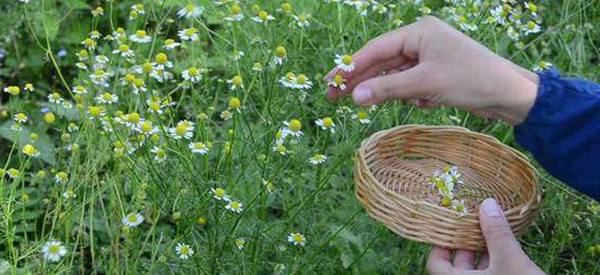
Just like Xanax, the Anxiety Relieving Plant That Grows in Your Backyard
Anxiety is a problem that many people struggle with. Traditional medicine can be quick to prescribe anti-anxiety drugs such as Xanax, Librium, Valium, or Ativan. While they’re effective – and even necessary for severe cases – they have problems including that they are addictive and habituating.
There are, however, plants and herbs that, like these drugs, boost the neurotransmitter gamma-aminobutyric acid (GABA). The excellent news is that arguably the best plant to do this may already be growing in your backyard. If it isn’t, you could plant some today. And the plant in question? Chamomile!
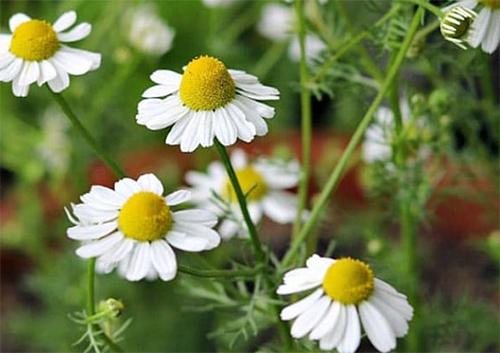
Chamomile is related to daisy and is native to western Asia, Europe, and India where it has been used as a medicine for many centuries. In more recent times, this plant is also found growing wild in large parts of the United States.
Although there are several varieties, there are two species that are prized as herbal plants:
- German Chamomile (Matricaria recutita or Chamomilla Recutita): This variety is an annual that self-seeds. The flowers have a hollow, gold cone in the center surrounded by multiple white petals. The leaves are delicate, and the plant reaches heights of 2 ½ feet or 76 centimeters.
- Roman Chamomile (Chamaemelum Nobile or Anthemis Nobilis): This plant is also known as English or Russian Chamomile. It’s a hardy perennial that grows more like a groundcover and forms compact, low mats. The white flowers have a small yellow cone surrounded by white petals. The leaves are slightly shiny, light green, and feathery.

The active ingredient in chamomile that has been researched the most is chamazulene. It is found in both species, but the amount is higher in German Chamomile. With both, the only part of the plant that is used is the flower, and it is the flowers that are used to prepare tea, oil (both essential and infused), and capsules.
Does Chamomile Help with Anxiety?
Chamomile, especially German Chamomile, has been the subject of more research than most other plants. The National Center for Biotechnology Information (NCBI), a branch of the National Institutes of Health, conducted two main studies:
- A study in 2017 found that 58% of participants reported that their anxiety symptoms were reduced after using chamomile for 8 weeks.
- Research in 2018 established that chamomile both reduced anxiety symptoms and increased morning cortisol levels.
Several constituents in chamomile have been identified. However, when it comes to dealing with anxiety, the most important one is apigenin. This is a flavonoid that influences Gamma-Aminobutyric Acid (GABA) which is a brain chemical that has been found to calm or boost mood. Low levels of GABA appear to be linked to anxiety and some mood disorders.
How to Grow Chamomile
It’s not difficult to grow Chamomile if your garden or in a pot if you have more limited space. However, German Chamomile is better in pots. Both species should be planted in spring and are happy in either part shade or full sun and can be grown from seeds or seedlings.
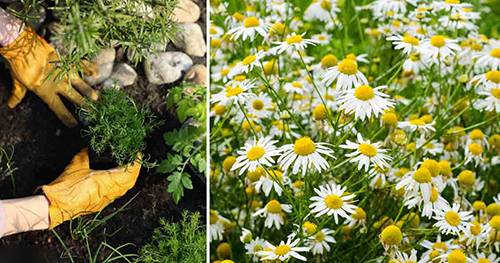
- German Chamomile: These tiny seeds can be scattered over prepared soil and then gently patted down. They will germinate after a week or 10 days. Growth is slow for the first month and then the plants grow rapidly. The flowering season lasts several months.
- Roman Chamomile: This variety can be grown from seed, cuttings, or roots. It will also self-seed easily. Again, fertilizer or rich soil will result in strong leaf growth but few flowers. Unlike German Chamomile, this type needs cooler growing conditions and more moisture.
Further good news is that once the plants are established, they need little – if any – care, and they are also relatively pest resistant.
How to Harvest & Dry Chamomile
Harvesting: Unlike with many other medicinal plants and herbs, there is only one part that is harvested and used: the flowers.
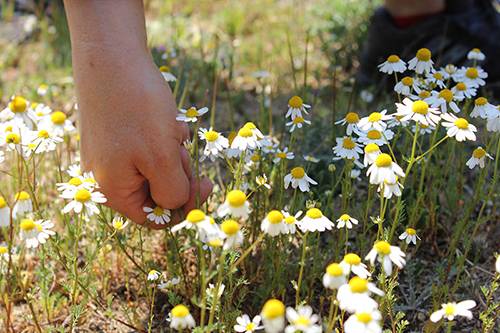
Chamomile blooms for many months and bears large numbers of flowers. This should allow you to harvest fresh flowers every 10 – 14 days. In fact, plants that have their flowers picked will flower better and for longer.
Fully open, mature flowers that have not begun to droop have been found to contain the most beneficial properties. The best time of day to pick the flowers is in the morning. Don’t pick them if they are still wet with dew or from rain; leave them to dry naturally.
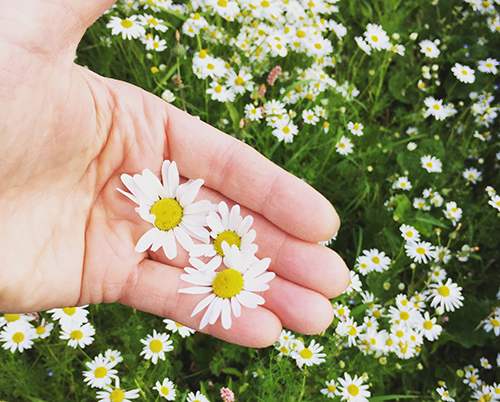
Only remove the flower head when you harvest Chamomile. Be careful when you do so not to pull off stems or damage the plant. Rather nip them off with your fingernails or use scissors to cut through the stem immediately below the flower.
If you want to allow your Chamomile plant(s) to self-seed or you want to collect seed to plant the following season, remember to allow some flowers to go to seed.
Drying: After picking the flowers, you can either wash them or gently shake them to remove any dirt or insects that may be present. If you wash them, you need to pat the blooms dry afterward.
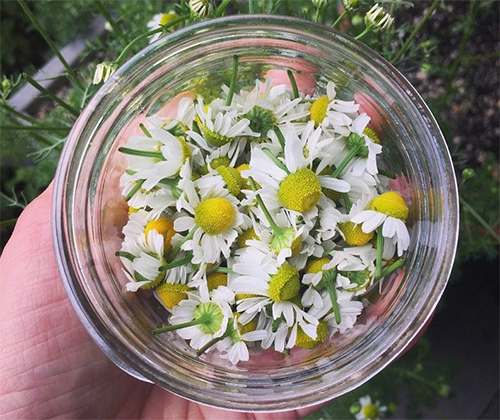
You have two options when it comes to drying:
- You can allow the flowers to air dry by spreading them out in a single layer on a clean cloth or brown paper. Place them in a warm, dark place to dry for a week or two.
- Alternatively, you can use a dehydrator or your oven. Be careful that you gently dry the flowers and don’t burn them; use the lowest possible setting and check the blooms frequently.

Correctly dried flowers can be stored in an air-tight jar for a year. However, if flowers are not properly dry, mold will form and you will have to throw the flowers away.
Some individuals prefer to pick just enough flowers for a cup or pot of tea made with fresh rather than dried flowers.
Chamomile Preparations
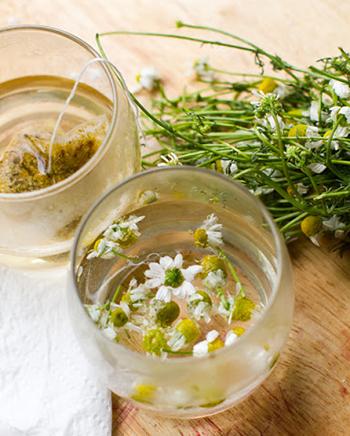 You can get Chamomile as tea, oil, or capsules. The most common form for the treatment of anxiety is as an herbal tea. If you can’t grow your own, you can buy loose tea or tea bags from health stores. If you are making your own, you’ll find it easy to do:
You can get Chamomile as tea, oil, or capsules. The most common form for the treatment of anxiety is as an herbal tea. If you can’t grow your own, you can buy loose tea or tea bags from health stores. If you are making your own, you’ll find it easy to do:
- Fresh Chamomile: Place 6 – 8 teaspoons of flowers into a cup.
- Dried Chamomile: Place 2 – 3 teaspoons of flowers into a cup.
With both:
 Pour boiling water over the flowers
Pour boiling water over the flowers- Allow the tea to draw for 5 to 10 minutes depending on how strong you want it. However, if it is left too long the tea may develop a slightly bitter taste.
- Don’t add milk but some people enjoy using lemon or a little honey.
Chamomile also combines well with other plants such as lavender, mint, or lemon balm. Again, you can experiment until you find a flavor you really enjoy.
Chamomile tea can be enjoyed hot or iced, and it will stay fresh and potent for up to 48 hours if it is stored in the fridge.
It is suggested that you don’t drink more than four cups of Chamomile tea a day.
Warnings and Cautions
There’s little evidence that Chamomile has any negative effects. However, individuals should avoid this plant if they:
- Are pregnant or breastfeeding
- Suffer from pollen allergies
- Are taking anti-anxiety medication or herbs that treat anxiety or cause drowsiness
Ingesting too much of this plant can cause vomiting and dizziness in some people so adhere to dose and usage directions or guidelines.
Finally, it’s important that you consult with your healthcare practitioner, especially if you have a medical condition or are on medication, before you start using any remedy, including natural ones!
You may also like:
 The 7 Most Powerful Medicinal Tea Blends
The 7 Most Powerful Medicinal Tea Blends
How to Make A Self-Sufficient Backyard on 1/4 of an Acre (Video)
5 Calming Herbs to Soothe Anxiety

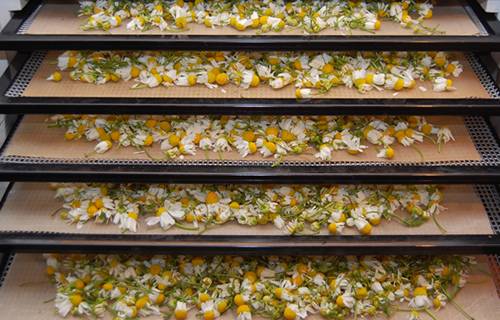
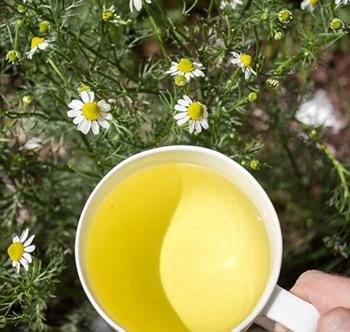 Pour boiling water over the flowers
Pour boiling water over the flowers
Good article
Hi Dr.John Ure,
Thank you for your feedback.
We really appreciate it!
God bless!
Could you freeze dry these Camomile flowers?
Hi Caren,
Thank you for your comment.
Yes, you can freeze the Chamomile flowers as well.
Wrap the flower heads well in aluminum foil. Get as much air out of the foil packet as possible without squishing the flowers.
Store the packet in your freezer.
Frozen chamomile keeps its flavor for about 6 months as long as it was well wrapped for freezing and hasn’t been thawed and re-frozen.
God bless!
Wonderful article! Thank you for sharing. I especially like that you’ve shared many photos of what the plant actually looks like.
Thank you for sharing all this great information.
Hi Linda,
Thank you for your feedback.
We are glad you found this article useful.
God bless!
Thank you, well written, and very helpful! Anxiety is really prevalent today!
Hi Shaman,
Thank you for your comment.
Yes, Anxiety is prevalent today, unfortunately.
We are glad you found this article useful!
God bless!
This is such a helpful and informative article! Thank you for sharing!
I really enjoyed this informative article. I recently bought the Forager’s Guide and am looking forward to spring, when I can go out and find some of these treasures. Meantime, I’ll be looking online to see where I should start in my area. I drink camomile tea at night sometimes, and it really knocks me out. So I don’t know that I can take it during the day to relieve anxiety, but some day hikes to forage will do me a world of good! I’m just beginning down this “natural” road, and honestly, it was Dr. Apelian’s inspiring video and story that prompted me to get off my butt and hop to it. I love your website. Thank you!
Very informative. Thank you.